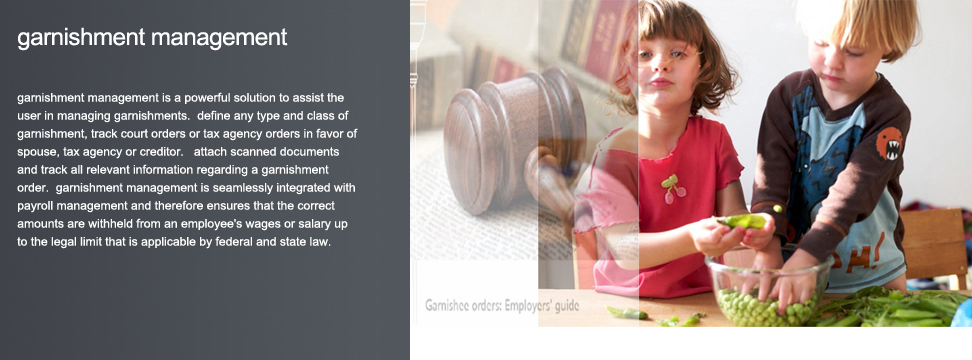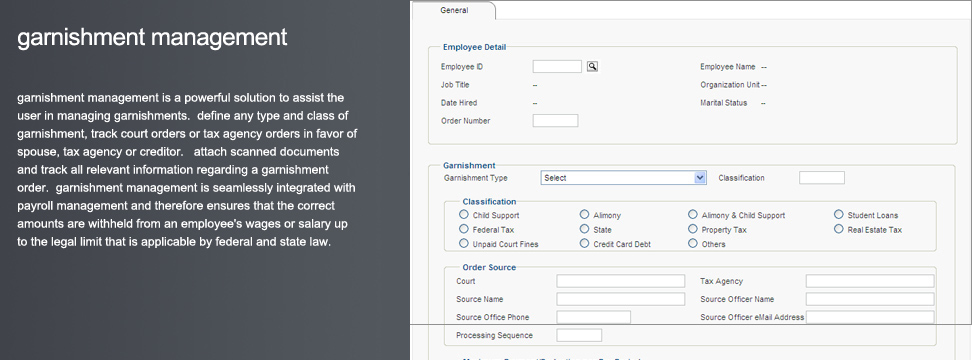Interact HRMS Garnishment Management Module Overview
The Garnishment Management module in Interact HRMS provides a comprehensive solution for managing employee garnishments, ensuring compliance with legal requirements and automating garnishment processing within payroll. With options to define various types and classes of garnishments, track court orders or tax agency instructions, and manage all related documentation, this module offers organizations a structured approach to garnishment management. Seamlessly integrated with Payroll, the Garnishment Management module automatically withholds the correct amounts from employee wages, ensures proper approvals, and processes payments to the appropriate payees, supporting compliance with federal and state laws.
This module is ideal for organizations that need to handle garnishments related to court orders, tax agency demands, or creditor claims, allowing them to ensure timely and accurate deductions. By automating garnishment workflows, supporting comprehensive record-keeping, and providing alerts for key events, the Garnishment Management module reduces administrative effort, ensures accuracy, and supports compliance with garnishment laws.
Defining Garnishment Types and Classifications
The Garnishment Management module allows HR and payroll teams to define any type and class of garnishment, ensuring flexibility in managing different types of garnishment orders. Key options include:
- Garnishment Classification: Classify garnishments based on their purpose or origin, such as tax-related, spousal support, or creditor claims.
- Garnishment Types: Define specific types of garnishments within each classification, tailoring garnishment options to meet various legal and policy requirements.
These definitions provide a structured framework for managing different types of garnishment orders, ensuring that each garnishment type is handled appropriately based on its classification. For instance, spousal support garnishments may require different handling procedures than tax garnishments, and the module allows organizations to set up specific workflows and rules for each type.
Tracking Garnishment Orders and Relevant Documentation
The module supports comprehensive tracking of all garnishment orders, allowing organizations to keep detailed records of court orders, tax agency demands, and other instructions. Users can attach scanned copies of relevant documents, such as court orders or agency notices, directly to each garnishment record. This document management capability ensures that all supporting information is easily accessible and stored securely.
For example, if an employee receives a garnishment order from a tax agency, HR can upload a scanned copy of the order to the employee’s garnishment record, providing a complete history of the garnishment. This feature supports compliance with legal documentation requirements and ensures that all garnishment details are readily available for review.
Integration with Payroll for Automatic Withholding
The Garnishment Management module is fully integrated with the Payroll module, allowing garnishments to be processed automatically as part of the payroll run. Once a garnishment order is active, the module ensures that the correct amounts are withheld from the employee’s wages or salary based on the specified terms and up to the legal limit set by federal and state laws.
For instance, if a court order requires a specific percentage of an employee’s income to be garnished, the module calculates the amount and withholds it automatically during payroll processing. This integration reduces manual calculations and minimizes the risk of errors, ensuring that all garnishments are handled accurately and consistently within payroll.
Compliance with Legal Limits for Garnishments
The module ensures compliance with federal and state laws by automatically enforcing legal limits on garnishment amounts. This feature is critical in regions where garnishments are subject to strict regulatory limits, as it prevents organizations from withholding more than the maximum allowable amount. By adhering to these legal restrictions, the module helps organizations avoid compliance issues and potential legal disputes.
For example, if an employee’s garnishment reaches the maximum allowable limit, the system automatically stops withholding further amounts until it becomes legally permissible to resume. This automated enforcement of legal limits protects both the organization and the employee from excessive garnishment deductions.
Automated Alerts for Key Events
The module includes automated alerts to notify relevant stakeholders when specific events occur in the garnishment process. For instance:
- Employee Notifications: Employees receive alerts when a garnishment has been applied to their wages, keeping them informed of deductions.
- Supervisor and HR/Payroll Notifications: Supervisors and HR/payroll staff receive alerts when garnishment deductions reach specific targets or when an amount has been withheld, ensuring that all parties are aware of garnishment status.
These alerts help ensure transparency and facilitate communication among employees, supervisors, and HR. By keeping all parties informed, the module reduces misunderstandings and ensures that garnishments are handled openly and professionally.
Approval Workflow for Garnishment Processing
To ensure that garnishments are processed correctly, the module includes a built-in approval workflow. This workflow requires approvals from the appropriate personnel, such as HR, payroll officers, or supervisors, before garnishments can be processed in payroll. By implementing this approval process, the module ensures that garnishments are handled in compliance with organizational policies and legal requirements.
For example, a garnishment may require multiple approvals before payroll can withhold the specified amount. The approval workflow guides users through each step, ensuring that all necessary approvals are obtained before processing. This feature supports accountability and compliance, as each garnishment is reviewed by the appropriate individuals before action is taken.
Payee Definition and Automatic Payment Processing
The module allows organizations to define multiple types of payees for garnishment payments, such as spouses, tax agencies, or creditors. Each payee can be set up with specific payment details, ensuring that garnishment funds are directed to the correct recipients. Once garnishments are withheld, the module automatically processes payments to the designated payees by Check or Electronic Payment.
For example, if an employee’s garnishment is payable to a tax agency, the system generates an electronic payment to the agency once the garnishment is withheld. This automation reduces manual effort and ensures that garnishment payments are made accurately and promptly, supporting compliance with garnishment orders and reducing administrative workload.
Categorizing Filing Types and Case Categories
The Garnishment Management module includes options to categorize garnishment filings by Filing Types and Case Categories, providing additional structure for managing different garnishment orders. Filing types might include tax-related filings, court-ordered filings, or agency filings, while case categories can be used to classify garnishments by specific legal categories or purposes.
These categorizations support organized record-keeping, allowing HR teams to manage and retrieve garnishment records more easily. By categorizing garnishments based on filing and case type, the module provides a streamlined approach to managing multiple garnishments and ensures that each case is handled according to its specific requirements.
Real-Time Tracking and Reporting
The module includes tracking and reporting capabilities that allow HR and payroll teams to monitor garnishments in real-time. Reports can be generated to view garnishments by employee, garnishment type, payee, or case category, providing insights into the organization’s garnishment obligations and helping HR teams manage garnishment cases efficiently.
For instance, reports can be generated to show all active garnishments for a specific department, or to view total garnishment amounts by payee. Real-time tracking and reporting enable organizations to stay informed about garnishment activity, ensuring that all cases are handled in compliance with legal and organizational policies.
Summary: Interact HRMS Garnishment Management
The Interact HRMS Garnishment Management module provides organizations with a structured, automated solution for managing garnishments efficiently and in compliance with legal requirements. Key benefits include:
- Garnishment Type and Classification Definition: Define and classify garnishments to ensure tailored handling of each garnishment order.
- Order and Documentation Tracking: Track court orders, agency demands, and attach supporting documents for each garnishment case.
- Payroll Integration for Automatic Withholding: Ensure accurate garnishment deductions within payroll processing.
- Legal Compliance on Withholding Limits: Enforce federal and state limits to prevent excessive garnishment deductions.
- Automated Alerts: Notify employees, supervisors, and HR/payroll teams when garnishments are applied or reach target amounts.
- Approval Workflow: Require approvals for garnishment processing, ensuring compliance with organizational policies.
- Payee Definition and Payment Processing: Set up payees and automate garnishment payments by check or electronic transfer.
- Categorization by Filing Type and Case Category: Organize garnishment cases for efficient management and retrieval.
- Real-Time Tracking and Reporting: Generate reports to monitor garnishment activity, supporting compliance and transparency.
By combining these features, the Garnishment Management module enables organizations to manage garnishments efficiently, ensuring compliance with legal mandates and organizational policies. This structured approach simplifies garnishment handling, reduces administrative workload, and provides a transparent process for managing employee garnishments, benefiting employees and HR/payroll teams alike.


